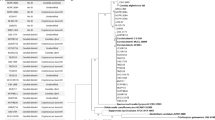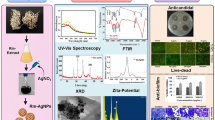Abstract
Pseudomonas aeruginosa is a ubiquitous and opportunistic bacterium that inhibits the growth of different microorganisms, including Gram-positive bacteria and fungi such as Candida spp. and Aspergillus fumigatus. In this study, we investigated the interaction between P. aeruginosa and Cryptococcus spp. We found that P. aeruginosa PA14 and, to a lesser extent, PAO1 significantly inhibited the growth of Cryptococcus spp. The inhibition of growth was observed on solid medium by the visualization of a zone of inhibition of yeast growth and in liquid culture by viable cell counting. Interestingly, such inhibition was only observed when P. aeruginosa and Cryptococcus were co-cultured. Minimal inhibition was observed when cell–cell contact was prevented using a separation membrane, suggesting that cell contact is required for inhibition. Using mutant strains of Pseudomonas quinoline signaling, we showed that P. aeruginosa inhibited the growth of Cryptococcus spp. by producing antifungal molecules pyocyanin, a redox-active phenazine, and 2-heptyl-3,4-dihydroxyquinoline (PQS), an extracellular quorum-sensing signal. Because both P. aeruginosa and Cryptococcus neoformans are commonly found in lung infections of immunocompromised patients, this study may have important implication for the interaction of these microbes in both an ecological and a clinical point of view.







Similar content being viewed by others
References
Chayakulkeeree M, Perfect JR. Cryptococcosis. Infect Dis Clin North Am 2006;20(3):507–544, v–vi. doi:10.1016/j.idc.2006.07.001.
Fraser JA, Giles SS, Wenink EC, Geunes-Boyer SG, Wright JR, Diezmann S, et al. Same-sex mating and the origin of the Vancouver Island Cryptococcus gattii outbreak. Nature. 2005;437(7063):1360–4. doi:10.1038/nature04220.
Mansour MK, Levitz SM. Interactions of fungi with phagocytes. Curr Opin Microbiol. 2002;5(4):359–65.
Feldmesser M, Tucker S, Casadevall A. Intracellular parasitism of macrophages by Cryptococcus neoformans. Trends Microbiol. 2001;9(6):273–8.
Levitz SM, Nong SH, Seetoo KF, Harrison TS, Speizer RA, Simons ER. Cryptococcus neoformans resides in an acidic phagolysosome of human macrophages. Infect Immun. 1999;67(2):885–90.
Chretien F, Lortholary O, Kansau I, Neuville S, Gray F, Dromer F. Pathogenesis of cerebral Cryptococcus neoformans infection after fungemia. J Infect Dis. 2002;186(4):522–30. doi:10.1086/341564.
Maschmeyer G, Braveny I. Review of the incidence and prognosis of Pseudomonas aeruginosa infections in cancer patients in the 1990s. Eur J Clin Microbiol Infect Dis. 2000;19(12):915–25.
Boucher HW, Talbot GH, Bradley JS, Edwards JE, Gilbert D, Rice LB, et al. Bad bugs, no drugs: no ESKAPE! An update from the Infectious Diseases Society of America. Clin Infect Dis. 2009;48(1):1–12. doi:10.1086/595011.
Gibson J, Sood A, Hogan DA. Pseudomonas aeruginosa-Candida albicans interactions: localization and fungal toxicity of a phenazine derivative. Appl Environ Microbiol. 2009;75(2):504–13. doi:10.1128/AEM.01037-08.
Kerr J. Inhibition of fungal growth by Pseudomonas aeruginosa and Pseudomonas cepacia isolated from patients with cystic fibrosis. J Infect. 1994;28(3):305–10.
Kerr JR, Taylor GW, Rutman A, Hoiby N, Cole PJ, Wilson R. Pseudomonas aeruginosa pyocyanin and 1-hydroxyphenazine inhibit fungal growth. J Clin Pathol. 1999;52(5):385–7.
Fisher AM. Inhibition of growth of Cryptococcus neoformans by cultures of Pseudomonas aeruginosa. Bull Johns Hopkins Hosp. 1954;95(4):157–61.
Teoh-Chan H, Chau PY, Ng MH, Wong PC. Inhibition of Cryptococcus neoformans by Pseudomonas aeruginosa. J Med Microbiol. 1975;8(1):77–81.
Choi JY, Sifri CD, Goumnerov BC, Rahme LG, Ausubel FM, Calderwood SB. Identification of virulence genes in a pathogenic strain of Pseudomonas aeruginosa by representational difference analysis. J Bacteriol. 2002;184(4):952–61.
Tan MW, Mahajan-Miklos S, Ausubel FM. Killing of Caenorhabditis elegans by Pseudomonas aeruginosa used to model mammalian bacterial pathogenesis. Proc Natl Acad Sci USA. 1999;96(2):715–20.
Choi KH, Schweizer HP. An improved method for rapid generation of unmarked Pseudomonas aeruginosa deletion mutants. BMC Microbiol. 2005;5:30. doi:10.1186/1471-2180-5-30.
Tully JG Jr, Latteri A. Paraplegia, syringomyelia tarda and neuropathic arthrosis of the shoulder: a triad. Clin Orthop Relat Res. 1978;134:244–8.
Heeb S, Fletcher MP, Chhabra SR, Diggle SP, Williams P, Camara M. Quinolones: from antibiotics to autoinducers. FEMS Microbiol Rev. 2011;35(2):247–74. doi:10.1111/j.1574-6976.2010.00247.x.
Zhang YM, Frank MW, Zhu K, Mayasundari A, Rock CO. PqsD is responsible for the synthesis of 2, 4-dihydroxyquinoline, an extracellular metabolite produced by Pseudomonas aeruginosa. J Biol Chem. 2008;283(43):28788–94. doi:10.1074/jbc.M804555200.
Machan ZA, Taylor GW, Pitt TL, Cole PJ, Wilson R. 2-Heptyl-4-hydroxyquinoline N-oxide, an antistaphylococcal agent produced by Pseudomonas aeruginosa. J Antimicrob Chemother. 1992;30(5):615–23.
Mowat E, Rajendran R, Williams C, McCulloch E, Jones B, Lang S, et al. Pseudomonas aeruginosa and their small diffusible extracellular molecules inhibit Aspergillus fumigatus biofilm formation. FEMS Microbiol Lett. 2010;313(2):96–102. doi:10.1111/j.1574-6968.2010.02130.x.
Holloway BW. Genetic recombination in Pseudomonas aeruginosa. J Gen Microbiol. 1955;13(3):572–81.
Rahme LG, Stevens EJ, Wolfort SF, Shao J, Tompkins RG, Ausubel FM. Common virulence factors for bacterial pathogenicity in plants and animals. Science. 1995;268(5219):1899–902.
Lee DG, Urbach JM, Wu G, Liberati NT, Feinbaum RL, Miyata S et al. Genomic analysis reveals that Pseudomonas aeruginosa virulence is combinatorial. Genome Biol. 2006;7(10):R90. doi:10.1186/gb-2006-7-10-r90.
Hogan DA, Kolter R. Pseudomonas-Candida interactions: an ecological role for virulence factors. Science. 2002;296(5576):2229–32. doi:10.1126/science.1070784.
Singh A, Del Poeta M. Lipid signalling in pathogenic fungi. Cell Microbiol. 2011;13(2):177–85. doi:10.1111/j.1462-5822.2010.01550.x.
Oliver A. Mutators in cystic fibrosis chronic lung infection: prevalence, mechanisms, and consequences for antimicrobial therapy. Int J Med Microbiol. 2010;300(8):563–72. doi:10.1016/j.ijmm.2010.08.009.
Hoboth C, Hoffmann R, Eichner A, Henke C, Schmoldt S, Imhof A, et al. Dynamics of adaptive microevolution of hypermutable Pseudomonas aeruginosa during chronic pulmonary infection in patients with cystic fibrosis. J Infect Dis. 2009;200(1):118–30. doi:10.1086/599360.
Bakare N, Rickerts V, Bargon J, Just-Nubling G. Prevalence of Aspergillus fumigatus and other fungal species in the sputum of adult patients with cystic fibrosis. Mycoses. 2003;46(1–2):19–23.
Hughes WT, Kim HK. Mycoflora in cystic fibrosis: some ecologic aspects of Pseudomonas aeruginosa and Candida albicans. Mycopathol Mycol Appl. 1973;50(3):261–9.
Taylor GW, Machan ZA, Mehmet S, Cole PJ, Wilson R. Rapid identification of 4-hydroxy-2-alkylquinolines produced by Pseudomonas aeruginosa using gas chromatography-electron-capture mass spectrometry. J Chromatogr B Biomed Appl. 1995;664(2):458–62.
Caldwell CC, Chen Y, Goetzmann HS, Hao Y, Borchers MT, Hassett DJ, et al. Pseudomonas aeruginosa exotoxin pyocyanin causes cystic fibrosis airway pathogenesis. Am J Pathol. 2009;175(6):2473–88. doi:10.2353/ajpath.2009.090166.
Acknowledgments
We thank all members of Del Poeta, Zhang and Luberto laboratories for discussion. This work was supported in part by Grants AI56168, AI71142, AI78493 and AI87541 (to M.D.P) from the National Institute of Health, in part by RR17677 (to M. D. P. and Y-M. Z) from the Centers of Biomedical Research Excellence Program of the National Center for Research Resources, and in part by NIH C06 RR015455 from the Extramural Research Facilities Program of the National Center for Research Resources. Dr. Maurizio Del Poeta is a Burroughs Wellcome New Investigator in the Pathogenesis of Infectious Diseases.
Author information
Authors and Affiliations
Corresponding authors
Rights and permissions
About this article
Cite this article
Rella, A., Yang, M.W., Gruber, J. et al. Pseudomonas aeruginosa Inhibits the Growth of Cryptococcus Species. Mycopathologia 173, 451–461 (2012). https://doi.org/10.1007/s11046-011-9494-7
Received:
Accepted:
Published:
Issue Date:
DOI: https://doi.org/10.1007/s11046-011-9494-7




